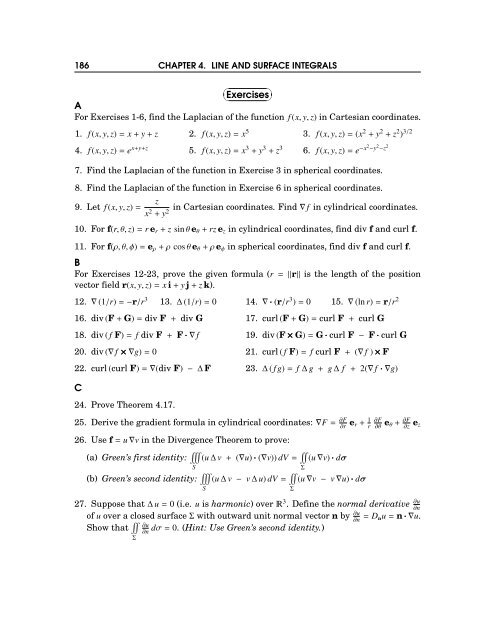Michael Corral: Vector Calculus
Michael Corral: Vector Calculus
Michael Corral: Vector Calculus
Create successful ePaper yourself
Turn your PDF publications into a flip-book with our unique Google optimized e-Paper software.
186 CHAPTER 4. LINE AND SURFACE INTEGRALS<br />
☛ ✟<br />
✡Exercises<br />
✠<br />
A<br />
For Exercises 1-6, find the Laplacian of the function f(x,y,z) in Cartesian coordinates.<br />
1. f(x,y,z)= x+y+z 2. f(x,y,z)= x 5 3. f(x,y,z)=(x 2 +y 2 +z 2 ) 3/2<br />
4. f(x,y,z)=e x+y+z 5. f(x,y,z)= x 3 +y 3 +z 3 6. f(x,y,z)=e −x2 −y 2 −z 2<br />
7. Find the Laplacian of the function in Exercise 3 in spherical coordinates.<br />
8. Find the Laplacian of the function in Exercise 6 in spherical coordinates.<br />
9. Let f(x,y,z)=<br />
z<br />
x 2 in Cartesian coordinates. Find∇f in cylindrical coordinates.<br />
+y2 10. For f(r,θ,z)=re r +z sinθe θ +rze z in cylindrical coordinates, find div f and curl f.<br />
11. For f(ρ,θ,φ)=e ρ +ρ cosθe θ +ρe φ in spherical coordinates, find div f and curl f.<br />
B<br />
For Exercises 12-23, prove the given formula (r =‖r‖ is the length of the position<br />
vector field r(x,y,z)= xi+yj+zk).<br />
12.∇(1/r)=−r/r 3 13.∆(1/r)=0 14.∇·(r/r 3 )=0 15.∇(lnr)=r/r 2<br />
16. div(F+G)=div F+div G 17. curl(F+G)=curl F + curl G<br />
18. div(f F)= f div F+F·∇f 19. div(F×G)=G·curl F − F·curl G<br />
20. div(∇f×∇g)=0 21. curl(f F)= f curl F + (∇f )×F<br />
22. curl(curl F)=∇(div F) −∆F 23.∆(fg)= f∆g + g∆ f + 2(∇f·∇g)<br />
C<br />
24. Prove Theorem 4.17.<br />
25. Derive the gradient formula in cylindrical coordinates:∇F= ∂F<br />
∂r e r+ 1 r<br />
26. Use f=u∇v in the Divergence Theorem to prove:<br />
∂F<br />
∂θ e θ+ ∂F<br />
∂z e z<br />
(a) Green’s first identity: S<br />
(u∆v + (∇u)·(∇v))dV= Σ<br />
(u∇v)·dσ<br />
(b) Green’s second identity: S<br />
(u∆v − v∆u)dV= Σ<br />
(u∇v−v∇u)·dσ<br />
27. Suppose that∆u=0(i.e. u is harmonic) over 3 . Define the normal derivative ∂u<br />
∂n<br />
of u over a closed surfaceΣwith outward unit normal vector n by ∂u<br />
∂n = D nu=n·∇u.<br />
Show that Σ<br />
∂u<br />
∂n<br />
dσ=0. (Hint: Use Green’s second identity.)








